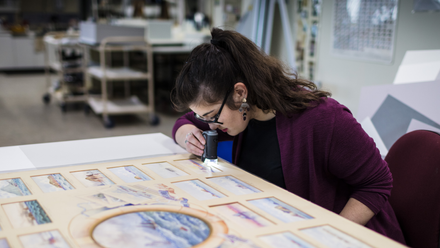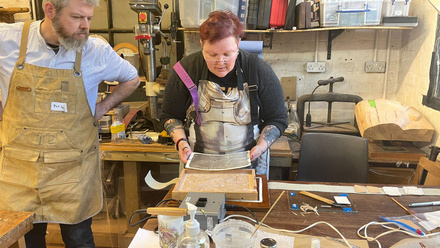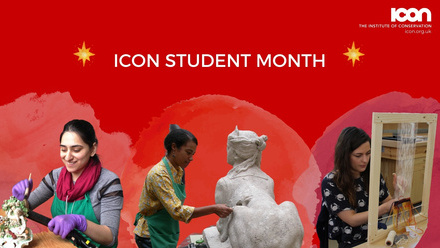As Head of Conservation at City & Guilds of London Art School since 2007, I have seen many changes in our department over the past 13 years. The whole structure of our programme was rebuilt with a considerable increase in science components and the introduction of new subjects; our studios were fully refurbished and our conservation lab obtained new facilities; we introduced new techniques, such as laser cleaning, to our teaching; and we started new collaborations including with Tbilisi Art Academy in Georgia and internships funded by Venice in Peril, a fund dedicated to conserving Venice’s architectural heritage and treasures.
However, due to two recent major developments at the Art School, I think 2020/21 is going to be one of the most exciting years for the department since I’ve been in the role.
The first is the launch in September 2020 of a new undergraduate award in the conservation of Books & Paper, following 18 months of rigorous planning, fundraising and preparations! This will be the only course of its kind to be offered in London, and in the UK and also sees the expansion of our MA Conservation to include both research and practical projects in Books & Paper at an advanced level.
The second significant development is the appointment of Heather Newton ACR as the new Head of Historic Carving, following Tim Crawley’s retirement from the role. Heather joins the Art School from Canterbury Cathedral where she has been Head of Conservation since 2013, and previously the Cathedral’s Head of Stonemasonry and Conservation from 2006.
Heather’s vast experience of managing large-scale restoration and conservation projects at one of the country’s most important historic buildings, will greatly benefit both the Historic Carving and Conservation Departments, fostering a new level of collaboration between the two disciplines and we hope it will provide enhanced opportunities for students on both courses.
Enhanced specialist training in the UK
As you probably know, Book & Paper conservation training in the UK has a long and important history and is very well respected internationally, attracting students from around the world, including the US where no specialist provision is currently available.
Now that we are offering the new undergraduate Books & Paper award, along with clear progression to MA Conservation, I am delighted that the UK’s educational provision for this specialist subject will be significantly enhanced, giving students a wider choice, enabling the continuation of the specialist knowledge and skills needed for the future preservation of our cultural heritage, and ensuring a regular stream of new professionals graduating into this thriving field of conservation.
We are grateful for generous grants made towards the project by the Foyle Foundation, Garfield Weston Foundation, the Steel Trust, the Pilgrim Trust, the Leche Trust, the Headley Trust and those who wish to remain anonymous.
BA (Hons) Conservation: Books & Paper
BA (Hons) Conservation: Books & Paper will sit alongside and complement our highly-regarded Conservation programme specialising in cultural objects made of stone, wood and the treatment of decorative surfaces; BA (Hons) Conservation: Stone, Wood & Decorative Surfaces.
The addition of this award will see the Conversation Department double in scale over the next three years, and follows the closure in 2018 of MA Conservation at Camberwell College of Arts, part of University of the Arts London (UAL). UAL are donating specialist equipment and materials to support the set-up of the new course and have provided some bursary funding to support students from groups underrepresented in Higher Education.
An extensive programme of works is currently underway to create and equip a new suite of conservation studios and facilities in our elegant Georgian terrace building in central London. This follows successfully reaching an ambitious fundraising target that has supported the set-up costs of the new course. And we’re delighted that despite the restrictions imposed by the Coronavirus pandemic, the works will be completed in time to welcome our new students in late September.
The building programme follows a rigorous review with Alan Higgs Architects and laboratory furniture and equipment specialist SplusB, alongside the advice of a panel of Books & Paper Conservation experts. The new studios and laboratory will be located near to the existing Conservation facilities, creating an extended Conservation area within the Art School.
Planning the design of the new teaching facilities is, of course, only one part of the in-depth preparations we have undertaken over the past 18 months. The syllabus has been developed with the ongoing advice and expertise of books & paper conservation specialists Edward Cheese ACR (The Fitzwilliam Museum), Jacqueline Moon ACR and Valeria Duplat (Tate) and Sonja Schwoll ACR (National Archives), and was validated with expert input from Christopher Harvey (College of Arms), ensuring that the course has currency and relevance with the active engagement of professional mentors and partner institutions from the outset.
As well as developing a deep understanding of the wider conservation knowledge and skills that are taught throughout the Conservation Department, students studying for the Books & Paper award will gain specialist experience including etching, bookbinding, leather tooling, marbling, paper and ink making, making pastels and crayons with traditional recipes and the history and science of western and eastern papers including wall papers. These specialist skills will support students with conservation and restoration projects focused on printed books, parchment, manuscripts and paper artworks, including fragile painted and drawn artworks, illuminated books and paper-covered globes.
The course also teaches modern book and paper conservation techniques that include chemical cleaning, fibre identification, spot tests and the use of ultraviolet photography. The completion of remedial conservation projects in their final year, ensures students experience valuable professional practice that will equip them for a career in conservation.
Because we’re located in central London, our students will have access to an unrivalled array of collections, research and projects owned by the many major institutions all within easy reach. Indeed, several institutions including Tate, Fitzwilliam Museum and National Archives, have already offered placement opportunities and live projects to students on the Books & Paper course.
So, with the new undergraduate award in Books & Paper conservation and the appointment of Heather Newton to lead the Historic Carving Department, I am really looking forward to what I’m sure will prove to be an incredible year for us, and the start of a new chapter in Conservation training at the Art School.
And it’s not too late for students to join us in September. We still have a few places on our MA Conservation, on which students can specialise in either the conservation of objects made from stone, wood and the treatment of decorative surfaces, or in the conservation of books and paper. Also we are operating a reserve list for both our undergraduate awards (Stone, Wood & Decorative Surfaces OR Books & Paper).
Anyone interested in finding out more is invited to book onto an online open day where I can give more details about the courses and answer any questions.
Header image: Dr Marina Sokhan demonstrating cleaning techniques using a Nd:YAG Q-switch Lynton Laser





